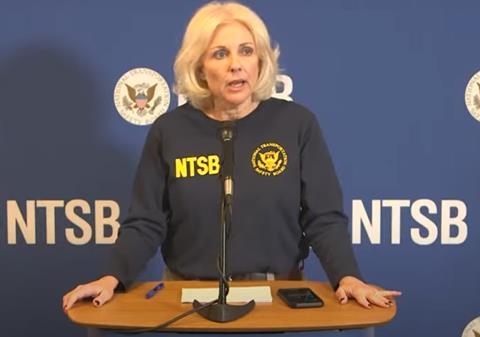July 17, 2025, 15:14:00 GMT
permalink Post: 11924436
1) There was a switch failure on a 737 that disabled the gate mechanism.
2) The switch on the 787 is of similar construction (edit: that's why it was included in the SAIB) .
3) Therefore, it is impossible that the accident 787 had a switch issue.
Do you understand that this is not logical?
And then you go on to cajole people who look forward to the AAIB thoroughly examining the switches they have in front of them, to generate actual evidence on whether these specific switches have an issue or not.
I agree that it is unlikely that the switches have an issue, but I still want the AAIB to look, so they can state it as a fact, instead of relying on guesswork.
You need to do that, even if it it's just to confirm the switches are ok, and what position they were in, in impact. And if the contacts work correctly , and any sign of degradation from in use. If you do not and there is a crash in a few months time .....
It's how they do air crash investigations.
Subjects
AAIB (All)
Special Airworthiness Information Bulletin
Links are to this post in the relevant subject page so that this post can be seen in context.
Reply to this quoting this original post. You need to be logged in. Not available on closed threads.
July 17, 2025, 16:23:00 GMT
permalink Post: 11924461
Subjects
AAIB (All)
Special Airworthiness Information Bulletin
Links are to this post in the relevant subject page so that this post can be seen in context.
Reply to this quoting this original post. You need to be logged in. Not available on closed threads.
July 17, 2025, 18:11:00 GMT
permalink Post: 11924527
Subjects
AAIB (All)
FAA
Special Airworthiness Information Bulletin
Links are to this post in the relevant subject page so that this post can be seen in context.
Reply to this quoting this original post. You need to be logged in. Not available on closed threads.
July 18, 2025, 04:23:00 GMT
permalink Post: 11924808
If something new comes up - then either reopen or someone can start a new one.
Last edited by T28B; 18th July 2025 at 14:32 . Reason: rant placed in the spoiler
Subjects
AAIB (All)
AvHerald
FAA
Fuel (All)
Fuel Cutoff Switches
NTSB
Special Airworthiness Information Bulletin
Links are to this post in the relevant subject page so that this post can be seen in context.
Reply to this quoting this original post. You need to be logged in. Not available on closed threads.
July 20, 2025, 19:33:00 GMT
permalink Post: 11925921
The head of the US National Transportation Safety Board (NTSB) has criticised recent news stories about the 12 June crash of an Air India Boeing 787-8, aligning with a statement from India’s Aircraft Accident Investigation Bureau (AAIB).
“Recent media reports on the Air India 171 crash are premature and speculative,” NTSB chair Jennifer Homendy said on 18 July. “India’s Aircraft Accident Investigation Bureau just released its preliminary report. Investigations of this magnitude take time.”
Homendy does not specify which media reports she takes issue with.
In recent days, The Wall Street Journal and Reuters, citing unnamed sources familiar with US officials’ assessment of evidence, reported that audio from the crashed jet’s cockpit voice recorder indicates the captain had moved the fuel control switches to the “CUTOFF” position. The reports said that the first officer was the pilot who asked why the switches had been moved.
A source who is also familiar with aspects of the investigation confirms that information to FlightGlobal.
Investigators have not released information to support such a scenario.

NTSB chair Jennifer Homendy warns against “speculative” media reports
The 787-8 was operating flight 171 from Ahmedabad to London Gatwick airport. It crashed shortly after taking off, killing 241 of 242 people aboard and 19 people on the ground.
The AAIB’s 11 July preliminary report said that about 3s after taking off, the two cockpit fuel control switches – each controls fuel to one of the jet’s two GE Aerospace GEnx turbofans – were switched to the “CUTOFF” position. The switch for the left-side engine moved first, with the right-side switch moving within about 1s.
The turbofans then lost thrust. One of the two pilots – the report did not specify which – asked the other why he moved the switch; the other then denied doing so.
Starting 10s after the switches were set to “CUTOFF”, both were switched back to “RUN”, causing the turbofans to begin restarting, but not in time to prevent the jet from crashing.
The 787’s flight data recorder noted the moment the actual physical switch moved to the “CUTOFF” position and then when it moved back to the “RUN” position, a source tells FlightGlobal. Those moments were plotted on a graph showing engine thrust falling off after the switches were moved to “CUTOFF”, and then returning after they were moved to “RUN”.
Because that data reflects the physical movement of the switch, a loss of fuel caused by another problem elsewhere in the 787’s electrical system is unlikely, the source says.
The Federal Aviation Administration on 11 July issued a Continued Airworthiness Notification to the International Community (CANIC) saying that the AAIB’s “investigation to date has found no urgent safety concerns related to the engines or airplane systems of the Boeing Model 787-8”.
On 17 July, the AAIB issued an “Appeal”, saying, “It has come to our attention that certain sections of the international media are repeatedly attempting to draw conclusions through selective and unverified reporting”.
“Such actions are irresponsible… We urge both the public and the media to refrain from spreading premature narratives that risk undermining the integrity of the investigative process,” it adds. “The AAIB appeals to all concerned to await publication of the final investigation report.”
Citing that document, the NTSB’s Homendy said on 18 July, “We fully support the AAIB’s public appeal… and will continue to support its ongoing investigation”.
The AAIB’s preliminary report also notes that the FAA issued a Special Airworthiness Information Bulletin in December 2018 about a “locking feature” within fuel control switches on several Boeing models, including 787s. The locking feature is a safety device that requires the switches be lifted before being transitioned. It involves raised nubs that the switch must transition over.

A fuel control switch similar to that found on Boeing 787s, showing that the switch must transition over raised bumps
That 2018 bulletin warned about potential “disengagement” of the locking feature, which could allow the switches to “be moved between the two positions without lifting”, potentially causing “inadvertent” engine shutdown.
Though the FAA recommended inspections, its bulletin concluded that issue was “not an unsafe condition that would warrant airworthiness directive”.
The FAA reiterated that position in its 11 July CANIC, saying the fuel control switch design does not pose “an unsafe condition”.
Though the AAIB’s report cited the issue, it drew no link between it and the crash
Subjects
AAIB (All)
Engine Failure (All)
Engine Shutdown
FAA
Fuel (All)
Fuel Cutoff Switches
GEnx (ALL)
NTSB
Preliminary Report
Special Airworthiness Information Bulletin
Wall Street Journal
Links are to this post in the relevant subject page so that this post can be seen in context.
Reply to this quoting this original post. You need to be logged in. Not available on closed threads.